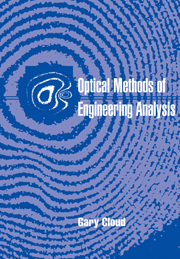Book contents
- Frontmatter
- Contents
- Acknowledgments
- 1 Introduction and orientation
- Part I Optics and interferometry
- Part II Photoelasticity
- Part III Geometrical moire
- Part IV Diffraction theory, optical processing, and moire
- Part V Moire interferometry
- Part VI Holographic interferometry
- Part VII Speckle methods
- 18 Laser speckle and combinations of speckle fields
- 19 Speckle photography
- 20 Speckle correlation interferometry
- 21 Electronic speckle pattern interferometry
- 22 Phase shifting to improve interferometry
- Author index
- Subject index
21 - Electronic speckle pattern interferometry
Published online by Cambridge University Press: 12 January 2010
- Frontmatter
- Contents
- Acknowledgments
- 1 Introduction and orientation
- Part I Optics and interferometry
- Part II Photoelasticity
- Part III Geometrical moire
- Part IV Diffraction theory, optical processing, and moire
- Part V Moire interferometry
- Part VI Holographic interferometry
- Part VII Speckle methods
- 18 Laser speckle and combinations of speckle fields
- 19 Speckle photography
- 20 Speckle correlation interferometry
- 21 Electronic speckle pattern interferometry
- 22 Phase shifting to improve interferometry
- Author index
- Subject index
Summary
The use of television image acquisition and computer image processing has revolutionized optical methods of metrology. A prime example is in the area of speckle correlation interferometry, which is discussed in this chapter. The implications of detector size are discussed, and limitations and advantages are outlined. An understanding of the material in Chapters 18 and 20 is strongly recommended.
Introduction
In spite of their obvious merits, holographic interferometry, speckle photography, and photograph-based speckle interferometry have not seen wide adoption by potential industrial and research users. The main reasons for this lack of acceptance seem to include the stability requirements, the necessity for photoprocessing, the requirements for postprocessing (such as image reconstruction and optical Fourier processing), and difficulties in fringe interpretation by persons not trained in optics. The processing and postprocessing are particularly troublesome, since they increase the time required to complete a cycle of experiments.
For these reasons it is natural to investigate the use of television systems to replace photographic recording materials and to use electronic signal processing and computer techniques to generate interference fringe patterns. This technique is electronic speckle pattern interferometry (ESPI), although it is also called video holography, TV holography, or electronic holography (EH). The basic concepts of ESPI were developed almost simultaneously by Macovski, Ramsey, and Schaefer (1971) in the United States and by Butters and Leendertz (1971) in England. The latter group, especially, vigorously pursued the development of the ESPI technique in both theoretical and practical directions. Later, Lokberg and Hogmoen (1976) and Beidermann and Ek (1975) also undertook successful research and development in ESPI.
- Type
- Chapter
- Information
- Optical Methods of Engineering Analysis , pp. 453 - 476Publisher: Cambridge University PressPrint publication year: 1995
- 5
- Cited by

